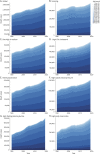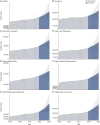Global Burden, Risk Factor Analysis, and Prediction Study of Ischemic Stroke, 1990-2030
- PMID: 37197995
- PMCID: PMC10351546
- DOI: 10.1212/WNL.0000000000207387
Global Burden, Risk Factor Analysis, and Prediction Study of Ischemic Stroke, 1990-2030
Abstract
Background and objectives: Ischemic stroke (IS), 1 of the 2 main subtypes of stroke, occurs because of brain ischemia caused by thrombosis of a cerebral blood vessel. IS is one of the most important neurovascular causes of death and disability. It is affected by many risk factors, such as smoking and a high body mass index (BMI), which are also critical in the preventive control of other cardiovascular and cerebrovascular diseases. However, there are still few systematic analyses of the current and predicted disease burden and the attributable risk factors of IS.
Methods: Based on the Global Burden of Disease 2019 database, we used age-standardized mortality rate and disability-adjusted life year to systematically present the geographical distribution and trends of IS disease burden worldwide from 1990 to 2019 by calculating the estimated annual percentage change and to analyze and predict the death number of IS accounted by 7 major risk factors for 2020-2030.
Results: Between 1990 and 2019, the global number of IS deaths increased from 2.04 million to 3.29 million and is expected to increase further to 4.90 million by 2030. The downward trend was more pronounced in women, young people, and high sociodemographic index (SDI) regions. At the same time, a study of attributable risk factors of IS found that 2 behavioral factors, smoking and diet in high sodium, and 5 metabolic factors, including high systolic blood pressure, high low-density lipoprotein cholesterol, kidney dysfunction, high fasting plasma glucose, and a high BMI, are major contributors to the increased disease burden of IS now and in the future.
Discussion: Our study provides the first comprehensive summary for the past 30 years and the prediction of the global burden of IS and its attributable risk factors until 2030, providing detailed statistics for decision-making on the prevention and control of IS globally. An inadequate control of the 7 risk factors would lead to an increased disease burden of IS in young people, especially in low SDI regions. Our study identifies high-risk populations and helps public health professionals develop targeted preventive strategies to reduce the global disease burden of IS.
Copyright © 2023 The Author(s). Published by Wolters Kluwer Health, Inc. on behalf of the American Academy of Neurology.
Conflict of interest statement
The authors report no disclosures relevant to the manuscript. Go to
Figures





Comment in
-
A Potential Forecast for Ischemic Stroke Burden in 2030: Are We There Yet?Neurology. 2023 Jul 11;101(2):55-56. doi: 10.1212/WNL.0000000000207517. Epub 2023 May 17. Neurology. 2023. PMID: 37197994 No abstract available.
References
-
- Murray CJ, Vos T, Lozano R, et al. . Disability-adjusted life years (DALYs) for 291 diseases and injuries in 21 regions, 1990-2010: a systematic analysis for the Global Burden of Disease Study 2010. Lancet. 2012;380(9859):2197-2223. - PubMed
-
- Phipps MS, Cronin CA. Management of acute ischemic stroke. BMJ. 2020;368:l6983. - PubMed
-
- Benjamin EJ, Muntner P, Alonso A, et al. . Heart disease and stroke statistics-2019 update: a report from the American Heart Association. Circulation. 2019;139(10):e56-e528. - PubMed
-
- Ding Q, Liu S, Yao Y, Liu H, Cai T, Han L. Global, regional, and national burden of ischemic stroke, 1990-2019. Neurology. 2022;98(3):e279-e290. - PubMed
Publication types
MeSH terms
LinkOut - more resources
Full Text Sources
Medical
Miscellaneous
